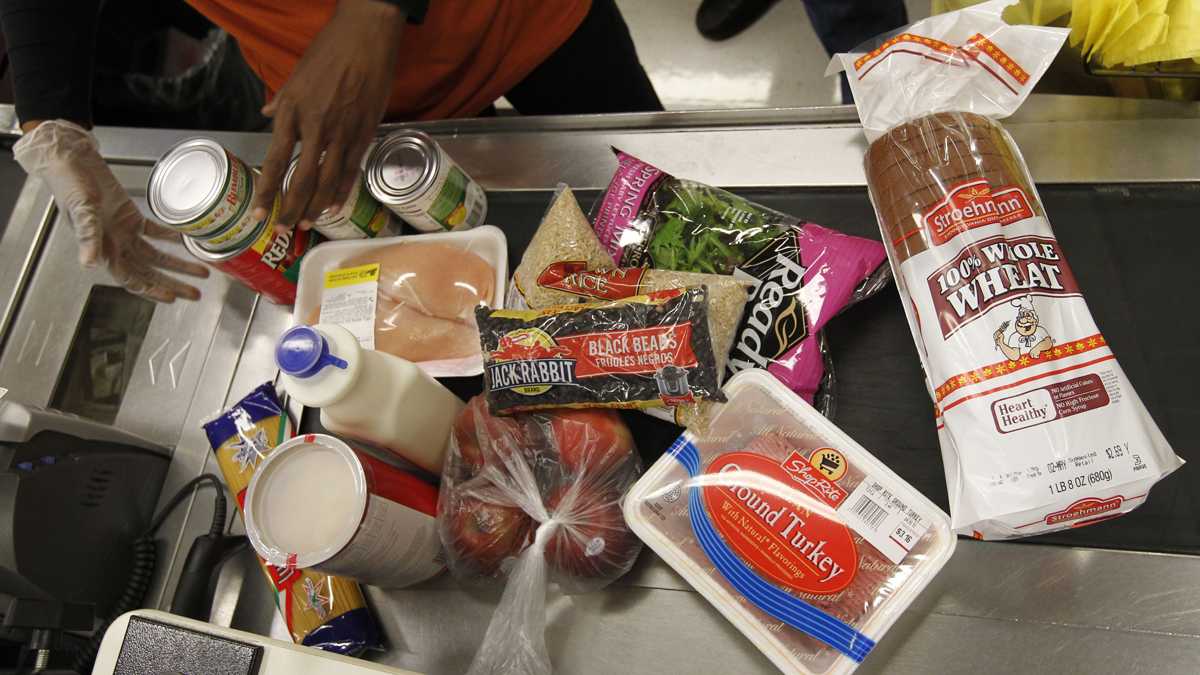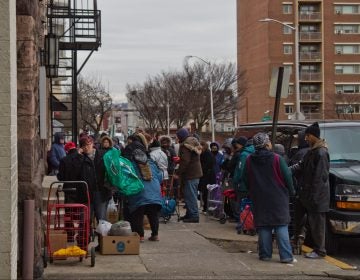Shutdown: SNAP funded through February but outage glitch unfixed
The Trump administration has said that SNAP would be funded through February, despite the shutdown. But if the closure continues to March, millions will be left scrambling.

(AP Photo/Matt Rourke, file)
This article originally appeared on PlanPhilly.
—
It wasn’t until Colleen Goodwyn got to the front of the line at Aldi that the cashier told her EBT (Electronic Benefits Transfer) wasn’t working. That meant the store couldn’t accept her SNAP (Supplemental Nutrition Assistance Program) benefits, sometimes known as food stamps.
Today, Goodwyn, 41, works as a nurse, but then, she was mostly unemployed. With EBT down, she had no other way to buy that month’s groceries.
So Goodwyn left her full cart at the store and went home.
“It’s embarrassing, really,” she said. “Especially when your kid’s with you.” At the time, her child was five or six years old.
“There was just no other option,” she explained. “I had to make do with whatever I had left at home.”
EBT outages are hard to pin down. Sometimes, it’s just one store that’s down. Sometimes, it’s several states.
And depending on the problem, EBT may be down for just a few minutes, or it may take days to fix or replace a machine.
For many Philadelphians who use SNAP, “down days” are par for the course.
“It’s not as frequent as bed bugs, but it’s up there,” said Lizz Tooher, RN, a community health nurse with the Mabel Morris Family Home Visit Program. She conducts home visits with families, most of whom live below the 100 percent poverty line. (To qualify for SNAP benefits, a family’s gross monthly income must fall below a certain level, based on the number of people in their household).
“[Outages are] almost so normalized that I don’t always even hear about it,” she said. “[If] I’m checking in on ‘do you have food in the fridge today,’ I’ll catch it more then.”
Outages can be even more difficult for those with physical disabilities, she said, those who rely on support for getting to a grocery store. Arranging another ride can be time-consuming and expensive.
And for families that work jobs with unpredictable schedules, sometimes the next grocery trip they can make isn’t for several days. Several days without fresh food comes with a “cascade of implications,” Tooher said, for both an individual’s physical and mental health.
In December, not long before the partial U.S. government shutdown, Congress passed a revised Farm Bill funding the federal food program. The Trump administration has said that SNAP would be funded through February, despite the shutdown. But if the closure continues through March, the 42 million Americans who receive the benefit will be left scrambling.
In the meantime, outages remain a threat, especially with so many federal workers furloughed or working without pay. The new Farm bill includes provisions intended to improve the electronic transfer benefit technology and address documented problems with system outages, mobile EBT technology and other glitches. But with the U.S. Department of Agriculture that oversees SNAP unfunded during the shutdown, fixes aren’t coming anytime soon.
Out of Business
When EBT is down at the Mariposa Coop in West Philadelphia, the first thing manager Daniel “DJ” Johnson does is post a sign at the door. Then, he’ll call STCR, a merchant services company that provides equipment and technical support.
“Especially on the 48th block of Baltimore Avenue, it’s pretty problematic if we can’t accept food stamps,” he said.
Outages seem to happen two or three times a year, he said, with the longest outage lasting about two hours. Each time, a few customers have to put their groceries back on the shelf, Johnson said.
“A good amount of folks actually shop at our coop because… [we provide] access to affordable produce,” said Meaghan Washington, marketing and communications coordinator for the Coop. “When the system is down it really does take a toll on those who need it and limits food access for those who receive those benefits.”
But only about 1 percent of coop shoppers use EBT. In other grocery stores, a system blackout can paralyze business.
At Spruce Hill’s Supremo Shop ‘n Bag where roughly 70 percent of shoppers rely on the federal benefit, manager Curtis Smart sees outages about every six months, some lasting more than six hours.
“It’s no good for business,” he said. “Because if we have to close down the business for a few hours…we’re not making money.”
John Osguthorpe works in the scanning department of the Supremo. When the EBT system fails, an announcement goes out over a loudspeaker and then store workers call in the IT department, he said. By department, he means one man, and he works out of New Jersey.
“So it takes some time,” Osguthorpe said.
Remote chokepoints
At first glance, EBT outages may seem straightforward.
In reality, the EBT system involves multiple players, all of which are invisible to the customer. Between swiping your card and having your transaction approved, a lot has to go right behind the scenes.
When grocery store staff like Johnson and Osguthorpe call technical support, they are often receiving advice about their physical point of sale (POS) devices, the EBT terminals that can be purchased through different vendors.
Many companies, like MerchantSource, offer 24-hour support over the phone, troubleshooting a variety of problems with puzzled retailers.
“If they drop and break the terminal, if it’s a merchant usage error — meaning they punched the wrong key — that can take five, ten minutes to retrain them,” said MerchantSource president Kim Lyons. If a device needs to be replaced, depending on the warranty, that process can take up to a week or two.
There could be other issues too, Lyons said. Sometimes a retailer’s SNAP certification has expired, or their merchant account has been closed, leading to a reader that doesn’t work.
For those who sell produce outside of a brick and mortar store, even more complications can arise. Wireless EBT terminals rely on cellular towers and the coverage they provide. Retailers at farmer’s markets often have to contend with spotty coverage in rural areas. And when a storm takes out a tower, everyone in that area is affected, including those who rely on EBT.
Ryan Cuck, interim director of Greensgrow, has experienced EBT connectivity issues when he’s selling produce outside. “We used to run our mobile market out of an aluminum bread truck, and inside the truck, the aluminum walls would block the signal, so we’d always have to go out of the truck and run the payment, and come back in the truck.”
Cuck also explains that managing several EBT terminals across a broad organization is essentially a full-time job. Greensgrow has received terminals from different sources, many of which are different models and have varying software updates and expiration dates.
“Because of security measures and just general technology improvements, we’re constantly cycling through machines, and someone has to stay on top of all of that and make sure things are all working properly for us to be able to provide consistent coverage to customers,” he said.
“Systemic Microagressions”
Outside of the physical terminal and the coverage it relies on, there are a few more twists in the EBT road that could be causing an issue.
Individual EBT readers don’t exist on their own — they each route card information to a payment processing system that either authorizes or declines the transaction. Usually, the information will go first to a third-party processor (TPP), and then to the state’s host processor. Any processor, and any line of communication between processors, can experience an outage.
In Pennsylvania, the company that is contracted by the state to process all EBT payments is Conduent. Before Conduent, JP Morgan provided this service.
According to the Pennsylvania Department of General Services, each state elects their EBT processor based on a bidding process.
This bidding process means that retailers don’t have a say in which company is handling their transactions. It also means that there is a small, regulated group of companies who are able to process SNAP payments at the state level.
“It creates real choke-points and also unfair market conditions around these things,” said Cuck of Greensgrow. “We don’t have a choice in the open market like we would with other types of payment processing to say ‘oh, we can compare these rates and know what vendor is going to be best for our needs.’”
Having less choice and competition also means that companies aren’t being pushed to innovate and provide better service, he says.
And when Conduent is having difficulty, the whole state feels it.
In the last two years, there has only been one Pennsylvania-wide EBT outage that has lasted longer than 20 minutes, according to the Pennsylvania Department of Human Services (DHS). It took place on August 17th, 2017 at 4 a.m., after a software update was loaded and caused a failure in the system.
“I get phone calls at 2 o’clock in the morning that I don’t necessarily want to get because the system’s having issues,” said Ralph Reichert, director of Office Services at DHS. In those cases, he said, Conduent reports the problem and how they working to resolve it. And if the outage lasts long enough, Reichert makes the information public.
More common than statewide outages are periods of “downgraded service.” According to Reichert, the banking industry requires that EBT transactions be successfully processed at least 99.9 percent of the time. Sometimes, though, the number dips below 99.9 percent across the state. The dip could be coming from any point in the chain, from an individual retailer or TPP to the communication between them.
Periods of “downgraded service” tend to average less than half an hour, Reichert estimates. He’s seen “seven or eight” of these events over the past two years. However, according to numbers provided by DHS, there were five months during that period where the total “system uptime” fell below 99.9 percent.
Just because somebody experiences an unsuccessful transaction doesn’t mean that they are necessarily walking away without their groceries, said Scott Cawthern, chief of staff for the Office of Income Maintenance. Sometimes, all it takes is a second swipe for the payment to go through. From the numbers that DHS sees, though, it’s impossible to know how each individual is affected.
Cawthern points out that EBT is usually available 24 hours a day. “Typically, these [periods of downgraded service] are resolved rather quickly,” he said. “Overall, the impact to our citizens is extremely low.”
But when EBT is down, shoppers who rely on SNAP don’t have a lot of options.
The United States Department of Agriculture (USDA), which oversees the SNAP program, offers one possible workaround. Manual food stamp vouchers are an offline alternative to the EBT system. A customer provides their card number, and the clerk calls a helpline number to check that the customer’s balance covers their purchase. If so, the voucher can be processed electronically later on.
If a retailer wants to make vouchers available to their customers, they need to request the forms from their third-party processor (TPP). A USDA representative said that retailers should also make sure their staff is trained in completing these transactions.
However, retailers are not required to provide manual vouchers. Of the four that PlanPhilly spoke to, none had ever used vouchers during an outage.
For customers, then, the question becomes how to manage the unpredictability of when EBT may be working — or not.
Some folks post on Facebook, either in public neighborhood groups or private pages, letting their network know that a certain store is “down.” Others check DownDetector, a website that gathers information from many sources, including Twitter, to give realtime reports of outages.
Still, though, “down days” often take folks by surprise.
“I hear, if I knew it was going to happen I would’ve planned three extra days of food. Or I would’ve managed better,” said Tooher, the community health nurse. “So then it becomes a self-defeat, too.”
For Tooher, EBT outages cause harm on many levels.
“I call them systemic microaggressions, where there’s just these minor humiliations that pile up for a low-income person,” she said. “Getting to the front of the line at a grocery store with $150 worth of food you can’t buy is definitely up there when I talk to moms.”
 PlanPhilly is one of 22 news organizations producing Broke in Philly, a collaborative reporting project on solutions to poverty and the city’s push toward economic justice. See all of our reporting at brokeinphilly.org.
PlanPhilly is one of 22 news organizations producing Broke in Philly, a collaborative reporting project on solutions to poverty and the city’s push toward economic justice. See all of our reporting at brokeinphilly.org.
WHYY is your source for fact-based, in-depth journalism and information. As a nonprofit organization, we rely on financial support from readers like you. Please give today.






